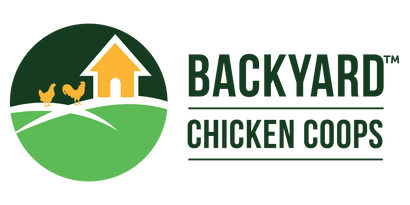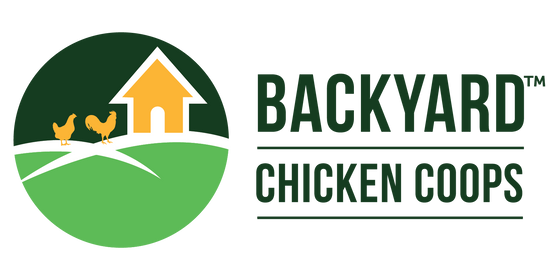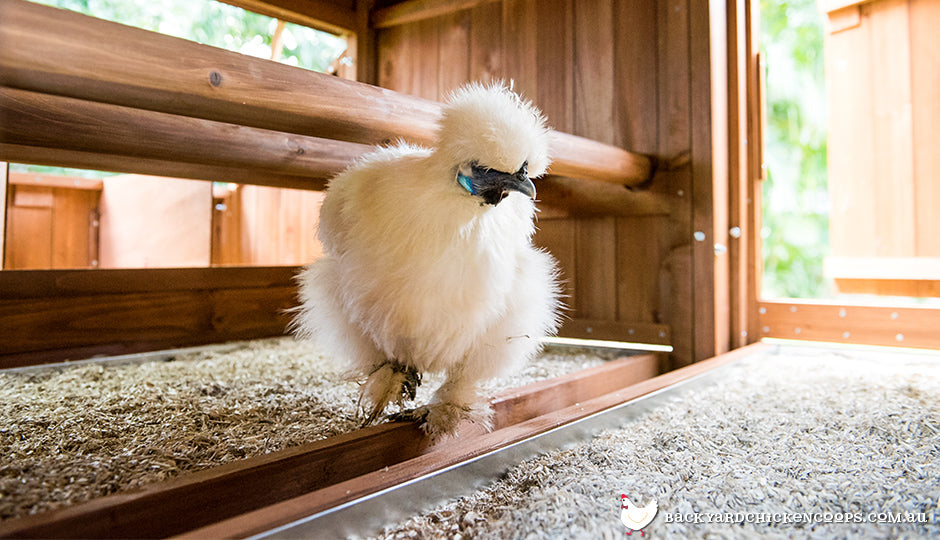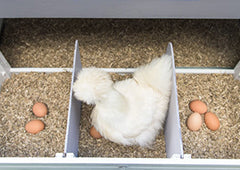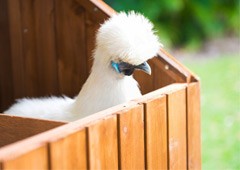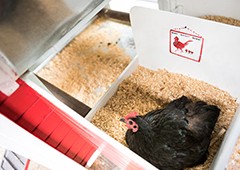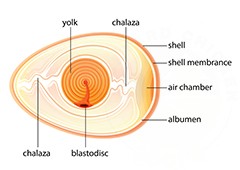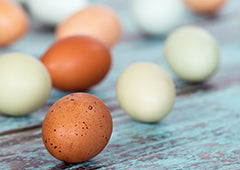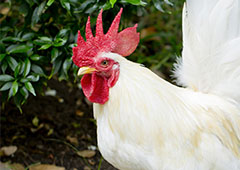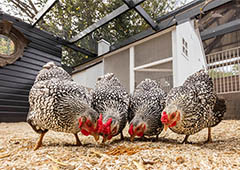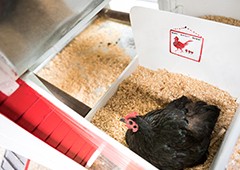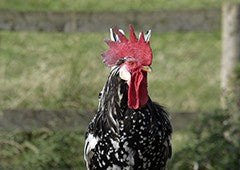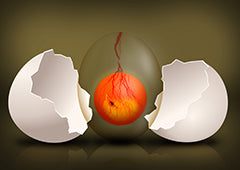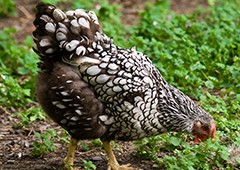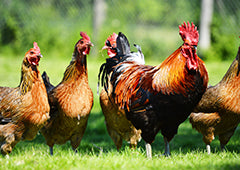For first time chicken owners there can be a lot of “umming” and “ahhing” over which type of animal bedding is right for your flock. Price, safety, odour and cleanliness are all important things you will need to consider before you make your first selection. Though some chicken owners may think, ‘cheaper is always better’, it is important to note that an inferior animal bedding can result in disease, respiratory problems and even death. So, this easy to read guide is an eggcellent starting point that will remove some of the pain and most of the uncertainty when it comes to selecting which animal bedding is right for your chooks.
What is animal bedding?
Ensuring that your hen house has plenty of fresh, clean and absorbent animal bedding is one of the best ways you can maintain the health and hygiene of your chickens. Animal bedding or floor litter is used in chicken coops to help absorb chicken manure that naturally occurs when keeping chooks, as well as providing comfortable footing for your chickens feet and a soft landing spot for the eggs they will lay. Traditionally chickens farmers used to use straw or hay however this is no longer the most reliable or cost effective way to ensure your chicken coop and chooks stays squeaky clean.
How often should I change the animal bedding?
Generally speaking animal bedding should be changed whenever you smell a build-up of bad odours or if there are any obvious signs of mess. This being said, changing your animal bedding regularly does not cause any harm to your chickens, but leaving your chickens in a messy coop often results in a number of possible problems. So, in short, make sure you clean your coop when there is cause to do so. Additionally, it's always a good idea to disinfect your coop with a natural cleaner, such as apple cider vinegar.
What are the dangers of an inferior quality animal bedding?
To put it simply, a clean coop means healthy chickens. In other words, if your chickens have piles of manure at their feet and there are mould spores, as well as dust present in their bedding, it’s imperative that you realise that your flock is at a genuine risk of illness, disease and respiratory problems. Some chicken lovers are very vigilant and will spot clean or “poo pick” the animal bedding on a daily basis, however this isn’t essential. So long as you clean out the coop every fortnight and monitor the state of the bedding, in all likelihood your coop will stay at a reasonable level of cleanliness and your chickens should remain healthy.
What are the different types of animal bedding?
Hemp animal bedding is one of the best types of bedding available for any chook lover, or any animal owner for that matter. Essentially, hemp animal bedding is made from the stalk of the cannabis plant known as the hurd. Hemp bedding is an odourless, absorbent and organic product that will not only help keep your coop stay cleaner for longer, but will also act as a natural pesticide, which will keep all sorts of creepy crawlies out of your coop. Hemp bedding can be slightly on the premium side when it comes to pricing but the benefits are many. If you are the type of chicken or animal lover who wants to best for their pets, make sure you consider hemp bedding first and foremost. For more information about the benefits of hemp bedding click here.
Absorbency... 10/10
Safety... 10/10
Warmth... 10/10
Overall rating... 10/10
Straw
There are lots of different straw options available: wheat, oat, barley, rye and so on. Some straws, like wheat and oat, are particularly absorbent, which will make cleaning your coop easier, however, it often doesn’t hold up well in the rain and can easily become mouldy, unhygienic and smelly. Straw is reasonably inexpensive but won’t last you very long when used as animal bed. To this point, some animals may try and eat the straw, which in turn may cause problems due to sanitation issue if the bedding is not clean.
Absorbency... 6/10
Safety... 3/10
Warmth... 4/10
Overall rating... 4/10
Leaves
Leaves are a nice natural alternative but they aren’t particularly absorbent. Some chicken lovers decide to cut leaves into their preferred choice of animal bedding, to help reduce waste, as well as promoting decomposition. It isn’t such a bad idea to mix old leaves through with another type of bedding, especially if you are considering creating a deep mulch system. Nevertheless, dried old leaves are incredibly cost efficient, especially if you have a lovely leafy backyard.
Absorbency... 2/10
Safety... 5/10
Warmth... 2/10
Overall rating... 3/10
Wood shavings
There are some fantastic varieties of highly absorbent wood shavings available on the market. Ideally the wood shavings will be small flakes of kiln dried wood. Ideally the wood shaving will have been dust extracted, otherwise your flock may experience respiratory issues, due to the excess of sawdust. Wood shavings are definitely a popular choice at the moment as it is reasonably absorbent and hygienic for a reasonable price. This being said, wood shavings do not have all of the benefits of hemp bedding, such as being a natural pesticide.
Absorbency... 8/10
Safety... 6/10
Warmth... 6/10
Overall rating... 7/10
Sawdust
Sawdust is definitely discouraged by most poultry gurus. Basically, sawdust in dangerous for your flock because it is very powdery and dusty, which can cause your girls respiratory problems, especially inside a sealed coop. Sawdust isn’t particularly absorbent and is also prone to developing maggots. This being said, sawdust is particularly good for dust paths and it doesn’t hurt to leave small piles of it inside the chicken run for your flock to enjoy.
Absorbency... 2/10
Safety... 1/10
Warmth... 2/10
Overall rating... 2/10
Hay
Hay can be quite expensive and it also isn’t one of the most durable animal beddings around. Some people prefer to use hay as it is quite a natural product, however it is more likely to develop mould spores, which will make your chickens sick. If you were to have guinea pigs or rabbits who might enjoy eating hay, it isn’t such a bad idea to leave a small bundle inside the coop.
Absorbency... 4/10
Safety... 2/10
Warmth... 4/10
Overall rating... 3/10
Newspaper
Newspaper is a popular choice for avid recyclers. Newspaper can be an effective form bedding, as most animals won’t feel tempted to eat it, however the texture of the material isn’t ideal, as it will quickly develop mould and be destroyed by the manure. As a temporary solution newspaper definitely isn’t a bad idea however it would not be wise to make a habit of using it as your go-to animal bedding.
Absorbency... 3/10
Safety... 3/10
Warmth... 3/10
Overall rating... 3/10
Though there are a lot of options on the market when it comes to animal bedding, the decision becomes a relatively easy one, so long as you have your flocks health and safety in mind. It’s not uncommon for people to want to try a number of different types of bedding in the early stages of caring for chickens, which is fine, as there is simply no risk in changing the type of bedding you use. So long as you remember, “a clean coops equals healthy chickens”, you aren’t likely to run into any major problems.
One way to ensure that your coop clean is to make sure that the nesting boxes and under trays are easily accessible, like the Taj Mahal, Penthouse and Mansion. These coops make cleaning out the animal bedding as easy as one, two, three.
From bedding to feed, as chicken keepers, we all want to do an eggcellent job for our feathered friends. There are plenty of things to consider when becoming a chicken parent. Many chicken keepers struggle to handle chicken health or behaviour issues, especially in the first few years of having a flock.
This is why I recommend Chickenpedia to all my readers. They have comprehensive online courses on everything you didn’t know you need to know and then some more! From healthcare to raising baby chicks to feeding and behavior, you’ll find beginner-friendly courses that’ll give you the knowledge and confidence to successfully look after your chickens.
As a member, you will get access to ALL their fantastic courses. No need to wing it, become the ultimate chicken eggspert! Check out Chickenpedia today!
